
|   |

|   |
Swami Vivekanand Music & Dance Festival, National Youth Day & The Bhakti Movement - Manjari Sinha e-mail: manjari@sinha.com January 22, 2024 SWAMI VIVEKANAND MUSIC & DANCE FESTIVAL The Ramakrishna Mission, Delhi, celebrated the 161st birth anniversary of Swami Vivekananda with a Music and Dance Festival at the Vivekanand Hall. The Sangeet Natak Akademi celebrated it as National Youth Day at the Meghdoot Theatre. The same devotional fervour was symbolized by 'Bhakti Movement' interpreting the poetry of saint poets in Bharatanatyam style by Gayatri Ravi at the Habitat Centre. Shri Ramakrishna Mission, Delhi, celebrates Swami Vivekananda's birth anniversary with great enthusiasm through their annual Vivekananda Music & Dance festival. This year's festival celebrating the 161st anniversary, opened with the melodious sitar recital by Sahana Bannerjee from Kolkata. Accompanied on tabla by Akram Khan, Sahana opened with the serenity of ragas Bilaskhani and Gujari Todi, sounding like a heartfelt invocation to the great saint. Sahana concluded her sitar recital with a dhun in Misra Jogiya. This was followed with a Dhrupad recital by Samit Mallick. 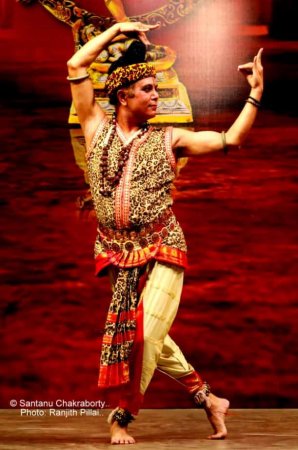 Santanu Chakraborty (Photo: Ranjith Pillai) Santanu Chakraborty, a senior disciple of Guru V. Krishnamurthy, opened his Bharatanatyam recital with the traditional Pushpanjali in praise of Ganesha - the remover of all obstacles, Saraswati - the goddess of learning, Lakshmi - the goddess of prosperity, Shiva and Durga, in the auspicious raga Nattai set to adi tala. The Shiva Panchakshara Stotra was presented more or less in a Varnam format with the five Sanskrit shlokas opening with syllables 'Na Ma Shi Va Ya' respectively being interpreted in a Ragamalika interspersed with intricate jathis in Talamalika, choreographed by Guru V. Krishnamurthy. The bhajan written by Saint Ravidasa about Krishna, Radha, and Gopis on the banks of river Jamuna, "Kamal lochan kati pitambar" came next. This also had sancharis of Gajendra Moksha, Bali dalan, Vamana avatara, and Ravana vadha. This bhajan was not only choreographed but also composed in raga Kalyani and sung soulfully by his versatile guru. This was followed by the famous Shiva Stuti "Bho Shambho, Shiva Shambho, Swayambho" written by Swami Dayananda Saraswati and composed in raga Revati set to adi talam. Santanu explained the background of this famous invocation in praise of Shiva, with the mythological story behind it and ended it with "Aangikam bhuvanam yasya..... tam numah sattvikam Shivam!" Santanu concluded his performance with a Kali bhajan. The mother goddess was worshipped by Ramakrishna Paramahamsa, who made her temple in Dakshineshwara. The Kali bhajan "Sadananda mai Kali, Mahakaler Manmohini..." instantly connected the devotees present there with Santanu's devotional spirit. The rest of the musical performances comprised a fantastic flute recital by Ajay Prasanna who played raga Madhuwanti; a duet Bhimapalasi with vocal by Sanghmitra Banerjee, and violin by Asghar Hussain; Raga Patdeep, Tarana and Meera bhajan by Meeta Pandit accompanied on harmonium by Vinay Mishra and tabla by Shambhunath Bhattacharya. The festival concluded with a sonorous sarod recital by Pt. Biswajit Roychaodhury accompanied on tabla by Durjasy Bhaumik. His choice of raga Chaayanat and Kamod itself were enough to put him in a class apart because both these ragas are a rare sight on a performance stage nowadays. His in-depth deliberation of both the ragas was remarkable. NATIONAL YOUTH DAY 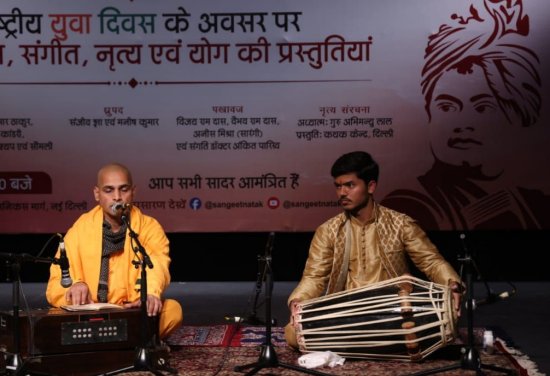 Swami Rudreshwarananda The Sangeet Natak Akademi under the Ministry of Culture celebrated Vivekananda Jayanti as National Youth Day with speech, music, dance, and yoga presentations at the Meghdoot Theatre. Swami Rudreshwarananda, the head of Ramakrishna Mission, Delhi, was invited to deliver a lecture on 'Swami Vivekananda: The Pioneer of Indian culture'. Speaking on the subject, Swami Rudreshwarananda underlined the fact that Swami Vivekananda was a knowledgeable musician as well, who sang Dhrupad and played many instruments. He also did a comparative study of Eastern and Western music and concluded that music is the essence of our culture. The most pleasant surprise came when Swami Rudreshwarananda presented the daily Aarati of the Ashram, written and composed by Swami Vivekananda in Dhrupad style. Playing the harmonium, which sounded like an organ, he sang the Aarati composition in Dhrupad form, set to a slow tempo of Chautala in accompaniment with pakhawaj, although the young pakhawaj player could not maintain the pace of the tala at a faster speed towards the end. 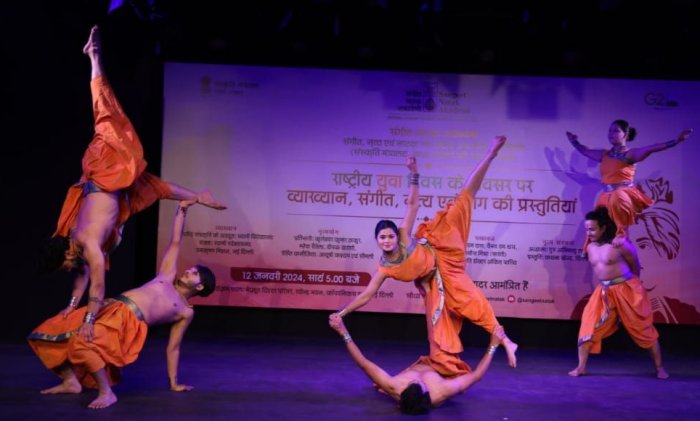 Nritya Yoga 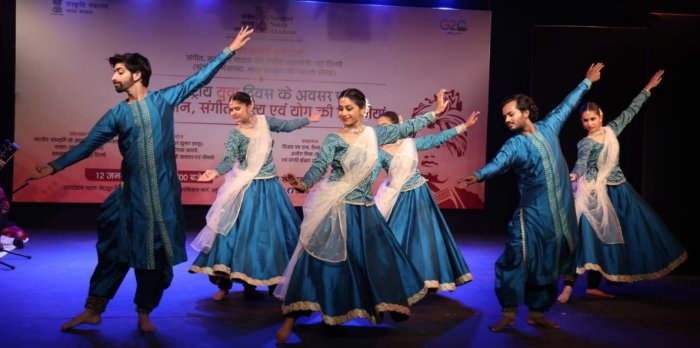 Adhyatma by Kathak Kendra This was followed by 'Nritya Yoga' presented by Kuleshwar Kumar Thakur, Mahesh Rautela, Deepah Kandari, Rohit Kanaujia, Aayushi Kashyap, and Saumeli. The delightful dance choreography by Kuleshwar merged aesthetically the dance with Yoga postures with Úlan. The next presentation was a Dhrupad recital by Sanjeev Jha and Maneesh Kumar accompanied on pakhawaj by Ankit Parikh, followed by a pakhawaj duet by Vijay and Vaibhav Das with Sarangi Lehera by Anish Mishra. The National Youth Day program reached its climax with 'Adhyatma', a Kathak choreography by Guru Abhimanyu Lal based on the historical speech of Swami Vivekananda in Chicago, presented by the Kathak Kendra. BHAKTI MOVEMENT Bhakti movement has played an instrumental role in promoting tolerance, compassion and inclusivity in society. Personal devotion and spiritual connection with the higher power fosters a sense of unity and understanding. Originating in India around the 7th century, the Bhakti movement was a spiritual revolution that sought to break away from rigid rituals and caste systems, promoting a more personal and emotional relationship with the divine. 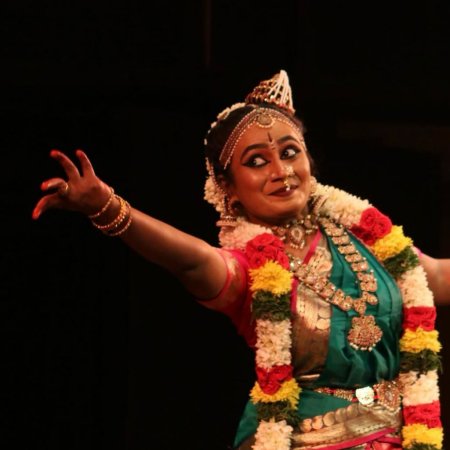 Gayatri Ravikumar The solo Bharatanatyam recital by Gayatri Ravikumar at the Stein Auditorium of the Habitat Centre aimed at uniting souls across time, genres, and languages through 'Bhakti Movement: a Cross-Cultural Perspective of Bhakti'. An Economics graduate, Gayatri is trained in Bharatanatyam under her mother Supriya Ravikumar in Trichy. She moved to Delhi for her academic studies. Currently pursuing her Masters in Economics from Ambedkar University, Delhi, Gayatri is dedicated to dance as well; this was proved with her very first solo performance in Delhi. Exploring the theme of bhakti through the works of poets from different languages, Gayatri offered her audience an opportunity to experience the richness and diversity of our devotional poetry tradition from a cross-cultural perspective. She selected three poets who approached bhakti in their own unique ways. Andal, the Tamil poet expressed her devotion with Shringar Bhakti, Tulasi Dasa approached his ishta deva Rama with Vatsalya Bhava, the motherly love. Saint Jana Bai's Abhanga expressed complete devotion, but this came only after Gayatri established her credentials as a competent Bharatanatyam dancer, opening with 'Melaprapti', the traditional invocatory item rarely seen these days. Melaprapti is performed in temples during the ritual processions of the Devata or on festivals. The particular Melaprapti presented by Gayatri was a treasure of Tanjavur tradition passed on through the inheritance of Tanjavur K.P. Kittappa Pillai to Supriya Ravikumar. Gayatri had the privilege to learn it from Vyjayantimala Bali. This was followed by the Bhakti movement poetry interpreted by Gayatri with total involvement. Andal, the 9th century Tamil poet, was a prominent figure of the Bhakti movement. Her devotion to Vishnu and her mystic experiences have made her a revered figure of the Bhakti movement of South India's literature and culture. Her poems filled with profound love and devotion are 'Thiruppavai' and 'Nachiar Thirumozhi'. Andal is known for her devotional and passionate love for Vishnu, particularly her dream of marriage with Ranganatha, the presiding deity of Srirangam, soulfully captured in her poem "Vaaranam Aayiram", movingly interpreted through Gayatri's abhinaya, which was not merely a mundane desire but a sacred aspiration symbolising the soul's search for complete union with the divine. The poem was composed in a Ragamalika set to adi talam. The popular bhajan of Tulasi Dasa, "Thumak chalat Ramachandra, bajat paijaniyan" was her next presentation, composed in Mishra Khamaj and Dadra Tala. Here the vatsalya rasa connected the poet with the divine depicting mother Kausalya's love for child Rama toddling endearingly with his jingling anklets. The final was a celebratory Abhanga "Nache Paanduranga" in raga Brindavani Sarang, adi talam, written by Jana Bai reaching the crescendo with the Kadana Kuthuhalam Thillana by Balamuralikrishna merging with the spiritual ecstasy of Jana Bai, offering a profound insight into the Bhakti movement and its connection with the divine. The live orchestra with Guru Supriya Ravi on nattuvangam, vivacious vocal support by Roshini Ganesh, mridangam by Chandrashekhar, and violin by Raghavendra Prasad enhanced the poetry and its portrayal. 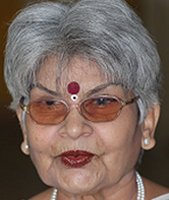 Manjari Sinha has an M.A. in Sanskrit and Music, and Sangeet Prabhakar in vocal, tabla, sitar and Kathak dance. She has regular columns in national dailies as a music and dance critic. |